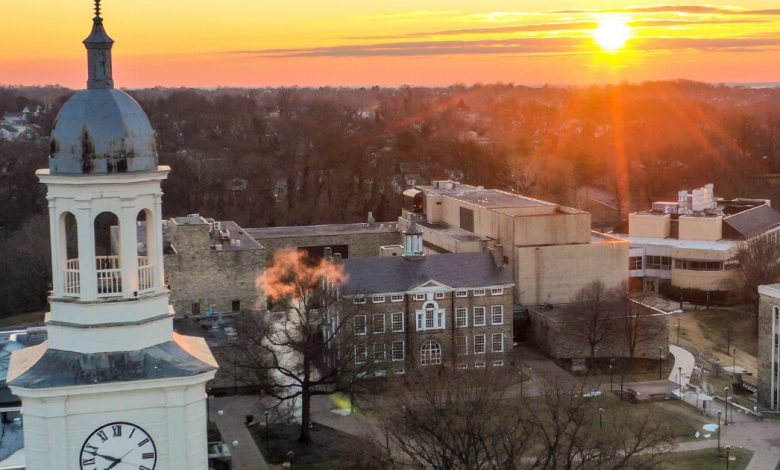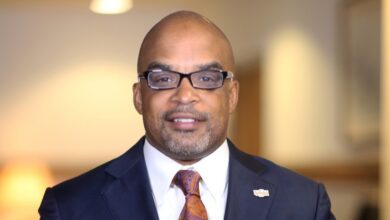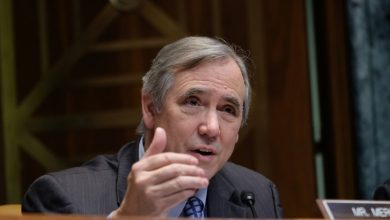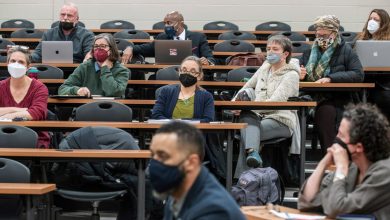A Race to the Top in Research

[ad_1]
The nation had severely shortchanged its HBCUs, he knew, while rewarding the predominantly white research universities where he’d spent much of his career. Faculty members at Wisconsin, Auburn University, and Rutgers University, were more likely to enjoy flexible teaching schedules, comfortable salaries, and state-of-the-art research equipment. Other historically Black colleges had reached out to him, and he’d turned them down.
“I was not interested in presiding over an institution where the primary purpose was to keep its doors open,” Wilson said.
The search chair was persistent, so he visited the campus, baseball cap turned backward, and stopped faculty members, without saying who he was, to ask about their work. Despite 4-4 teaching loads and heavy service and advising responsibilities, they talked about publishing articles in leading journals and finding the time to write books.
“They said this was a place where they never had to question whether they were part of a family,” Wilson said. “They were giving it everything they had, and more, even with parsimonious resources.”
Seeing an institution “pregnant with possibility,” he ended up taking the job and committing to help elevate the university’s stature as a major research university.
Today, Morgan State is one of a handful of HBCUs, including North Carolina A&T State, Howard, Florida A&M, and Prairie View A&M Universities, vying to join the ranks of Carnegie R1 universities. The coveted distinction, reserved for doctoral institutions with very high research activity, helps universities recruit top faculty members and scholars and win prestigious research grants. Among the 137 institutions classified as R1, not one is an HBCU.
Achieving R1 status is a tall order for any university, but for public historically Black colleges, it’s an especially difficult task. Many of them have suffered from decades of systemic financial neglect, leaving their research underfunded, their facilities outmoded, and scholars underpaid.
“If you don’t have the basic infrastructure to be competitive, we’re perpetuating the dynamic that exists today that the rich get richer, and we continue to tread water,” said David K. Sheppard, chief legal officer and chief of staff of the Thurgood Marshall College Fund, which advocates for public HBCUs. When he was general counsel at Delaware State University from 2016 to 2018, a lack of lab space meant that most of the physical lab research that the HBCU’s faculty received funding for had to be done at the predominantly white University of Delaware. “That’s crazy,” he said.
But as the nation comes to grips with the effects of racial discrimination — in policing, in health-care access, and in education — an infusion of money and support has buoyed minority-serving institutions, including HBCUs. That, plus the Biden administration’s commitment to better funding for those institutions, has given HBCU leaders renewed hope that R1 status is within reach.
Although they don’t all say so publicly, it’s clear they’re in a race to the top.
The classification was started in 1970 by the Carnegie Commission on Higher Education. It’s now produced by Indiana University’s Center for Postsecondary Research and updated every three years, with colleges grouped into more than 30 categories based on characteristics including teaching and research. It’s described as “the leading framework for recognizing and describing institutional diversity in U.S. higher education” and forms the basis for the categories used in rankings by such publications as U.S. News & World Report.
The race for R1 status makes the Carnegie classification’s project director a little uncomfortable. Victor M.H. Borden, who is also a professor of higher education and student affairs at Indiana University at Bloomington, said the R1 classification, for institutions with the largest research footprint, was never meant to signify that these institutions are any better than, say, a leading liberal-arts college, or an R2 institution with a strong teaching focus and a slightly smaller research footprint. The race, he worries, is part of the “prestige disease” in higher education.
Pushing for R1 status, which requires that institutions reach a number of benchmarks, including awarding at least 50 doctoral degrees and securing at least $40 million in federal support per year, makes sense for some institutions but may not for others. “No matter what we do, the field is always looking for a scaffolding on which to judge prestige,” Borden said.
For HBCUs like Morgan State, which have set reaching that tier as a key strategic goal, the race isn’t just for bragging rights. It’s also about ensuring that students have access to the expertise, research facilities, and curricula that will prepare them for graduate work or make them competitive for top jobs, especially in STEM fields.

Morgan State University
Elevating HBCUs to top-tier research status is also important to their regions and the nation, their advocates argue. These institutions are uniquely qualified to study problems like the racial disparities in health care that have been amplified by the Covid-19 pandemic. Other topics ripe for more research, their advocates argue, include the widening racial wealth gap, and the effects of cybersecurity, artificial intelligence, and climate change on minority communities.
On its quest for R1 status, Morgan State plans to expand several key areas of research already underway. One involves examining data from hundreds of brains of deceased people of African ancestry in search of hints to the causes of health disparities affecting African Americans. The joint research project was spearheaded by the Lieber Institute for Brain Development, which is affiliated with the nearby Johns Hopkins University.
Morgan State also plans to create a national center to ensure that artificial intelligence doesn’t harm minority communities. Bringing more-diverse experts to the table, its researchers say, can prevent bias from being baked into algorithms that shape decision making. In addition, the university is developing a noncognitive-assessment tool that predicts, without relying on standardized tests, who can succeed in college.
For a university accustomed to making do with less, recent infusions of money, and the promise of more, have allowed Morgan State to think big.
In 2020, the institution received a $40-million gift from the philanthropist MacKenzie Scott. Then last year, a federal judge approved a $577-million settlement, over 10 years, for Maryland’s four HBCUs, including Morgan State. It was the culmination of a 15-year battle, during which advocates for historically Black colleges argued that the state had unfairly allowed predominantly white public universities to roll out specialized academic programs that directly competed with those at the state’s HBCUs. The money will be divvied up based on enrollment, and Morgan State expects to get its first $15.1 million in July.
“We think, invested wisely, this could be a major step forward in enabling us to achieve R1 status,” Wilson said. Faculty members who’d been expected to teach eight classes per year are now teaching six, freeing up time for research. And the benefits, he said, would reverberate far beyond the campus.

Morgan State University
“It’s so important for Morgan to be a resident on the penthouse level of research, because there’s no other institution on that floor like it,” Wilson said.
Black and Hispanic workers remain underrepresented in science, engineering, and technology fields, and historically Black colleges remain a key pipeline for that talent. These institutions, which represent just 3 percent of American colleges and universities, graduate 25 percent of all Black STEM graduates, according to the UNCF. They also produce more than 40 percent of Black recipients of advanced STEM degrees, according to the National Association for Equal Opportunity in Higher Education (Nafeo), an umbrella group for historically and predominantly Black colleges. They do that despite enrolling many more low-income students, having far smaller endowments, and often lacking the sophisticated lab equipment their predominantly white counterparts enjoy. At Morgan State, for instance, four out of five science buildings are at least 80 years old.
Many R1 contenders start out at a significant disadvantage “because people with the resources have more capability to obtain more resources,” Borden said. Funding organizations tend to give money to well-known universities with a proven record of conducting research. These universities typically have grants offices and faculty members supported by research and teaching assistants. The Carnegie classification hasn’t created the resulting funding inequities, Borden said, but simply mirrors those that exist in higher education.
This past fall, in a meeting facilitated by the Thurgood Marshall College Fund and the Mitre Corporation, Borden met with representatives of all of the R2 HBCUs to explain the process of moving up to R1 and to hear their concerns about heavy teaching loads and other factors holding them back. Borden said he’d like to find a way to recognize institutions for more of the research they’re doing in social sciences and the humanities, areas where HBCUs do considerable research that “doesn’t always bring in the big bucks.”
“Historically, HBCUs have been woefully underfunded compared to their peers. That catches up with you when it occurs decade after decade,”
said Bruce Jones, vice president for research at Howard University. Howard was an R1 institution under previous Carnegie classification systems that were in place between 1987 and 2005, but moved down to R2 in the 2005 update.
Most HBCUs were established to educate formerly enslaved people and have continued to be known for their emphasis on teaching and service. “The foray into the research area is relatively new for HBCUs compared to other institutions,” Jones said. “We’re basically trying to play catch-up.”
To do that, “You not only have to attract top-notch research faculty — you have to sustain them so you don’t have constant turnover,” Jones said. That requires reasonably competitive salaries and state-of-the art facilities.
Howard, a private institution based in Washington, D.C., is planning to expand programs in climate science and cybersecurity, and it’s hiring more faculty across diverse disciplines who have a track record of bringing in research funding.
“We have faculty who have been funded on six different proposals,” Jones said. “Managing six grants can wear people out.” If a few prolific researchers retire, a university’s Carnegie status might take a hit. To encourage broader participation, Howard offers “minigrants” to allow researchers to pilot their studies and submit more compelling cases for funding.
Another HBCU in the race for R1 status is North Carolina A&T State University, one of the nation’s largest HBCUs, with just over 13,000 students. The institution, part of the University of North Carolina system, has a team that regularly pores over data and crunches the numbers to show how competitive it is with its peers, including those that have crossed over to R1. Since 2016, it’s been the top HBCU recipient of federal grants for science and engineering activities, taking in $22,704 in the 2019 fiscal year.
As colleges with more resources vie for the same pool of top faculty candidates, “we’ll have to up our game as well,” said the university’s chancellor, Harold L. Martin Sr.
Hiring more research faculty, expanding doctoral programs, upgrading labs, and expanding the staff to manage multimillion-dollar grants takes a major, sustained financial commitment, Martin said.
“It’s not cheap,” Martin said. “That means we have to continue to make the case to increase state appropriations that support our march to excellence and to R1 status.”
“States enthusiastically and routinely matched the 1862s, but they didn’t match the 1890s,” said Lezli Baskerville, president of Nafeo. “It turned out to be tens, maybe hundreds of millions of dollars that the 1890s are being denied for research.”
The settlement for Maryland’s four HBCUs, she said, could provide a blueprint for other HBCUs to push for the money they’ve been denied for decades. Last year, a legislative committee in Tennessee concluded that the state had shorted Tennessee State University by as much as half a billion dollars since 1957, by failing to provide matching funds to the historically Black land-grant university. Meanwhile, it was paying more than required to the state’s predominantly white land-grant college, the University of Tennessee at Knoxville. Today, Tennessee State faces hundreds of millions of dollars in deferred maintenance costs.
Moving from R2 to R1 is a “huge priority” for Tennessee State, according to the university’s president, Glenda Baskin Glover. She said she’s optimistic that the money the state owes, for which she’ll be fighting this legislative session, will help build the infrastructure the university needs to be competitive.
The Biden administration’s stalled Build Back Better infrastructure plan contains $10 billion for minority-serving institutions, including HBCUs, but the question of how the money would be divvied up has created tensions between advocates for Black and Hispanic-serving institutions. Colleges would have to compete for the funds, which could help them upgrade aging and crumbling buildings and attract top faculty.
Meanwhile, HBCU advocates continue to push for the HBCUs Ignite Excellence Act, which would provide money to help the colleges upgrade their aging infrastructure.
Todd Simmons, a spokesman for North Carolina A&T, said he can’t deny that the race to R1 has created more competition among HBCU allies. “I’d be a terrible liar if I said there wasn’t, but we’re all cheering for one another on any successes,” he said. “The fact that we’re finally getting the support we deserve” to expand cutting-edge research “is very encouraging.”
Wilson makes no apologies for saying he wants Morgan State, which rolled out the Twitter hashtag #R2NextStopR1, to get there first. But, he adds, “if one of us crosses the finish line before the others, I have no doubt it will be waiting there, extending its arm to welcome others.”
[ad_2]
Source link






